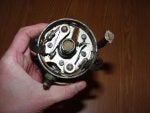OK, so this is how I timed my 2600 Spider with the Marelli twin point distributor.
I timed the car at 43.5 degrees BTDC at 5000 rpm (as many people said to retard the timing for lead-free gas), and didn't worry too much about the idle timing.
43.5 degrees is just left of the center of the letter M at the max advance mark (47 degrees).
Why did I pick 43.5 degrees? Well the standard static timing is 7 BTDC, and this is marked as F on the pulley. Several people had said to retard the timing between 3 and 4 degrees, so I decided to split the 7 degrees in half = 3.5 degrees. I measured the distance from TDC (marked as P) to the F mark with my calipers, divided by two and then subtracted this distance from the M mark, which is at 47 degrees.
I did get the dwell on the twin point distributor to be within spec (42-48 degrees). I checked the dwell on each set of points separately by placing a piece of cardboard between one set of points and then the other and keeping them equal as I adjusted them. I also adjusted the points in relation to each other, using the twin points info on the car disk DVD.
The car starts and runs well, but I think buying a 123 dizzy really is the way to go!
John






